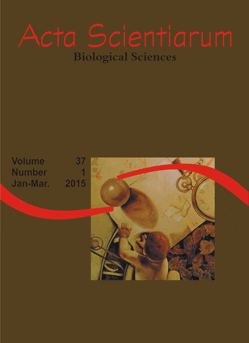<b>Optimization of culture conditions for tannase production by <i>Aspergillus</i> sp. gm4 in solid state fermentation
Resumo
Tannase is an industrially important enzyme produced by a large number of microorganisms. This study analyzed the production of tannase by Aspergillus sp. GM4 under solid-state fermentation (SSF) using different vegetable leaves (mango, jamun and coffee) and agricultural residues (coffee husks, rice husks and wheat bran). Among the substrates used jamun leaves yielded high tannase production. The Plackett-Burman design was conducted to evaluate the effects of 12 independent variables on the production of tannase under SSF using jamun leaves as substrate. Among these variables, incubation time, potassium nitrate and tannic acid had significant effects on enzyme production. A lower incubation time was fixed and supplementation with potassium nitrate and tannic acid were optimized using the Central Composite Design. The best conditions for tannase production were: incubation time of 2 days; tannic acid at 1.53% (w w-1) and potassium nitrate at 2.71% (w w-1). After the optimization process, tannase production increased 4.65-fold, which showed that the statistical experimental design offers a practicable approach to the implementation of optimization of tannase production.
Downloads
DECLARAÇÃO DE ORIGINALIDADE E DIREITOS AUTORAIS
Declaro que o presente artigo é original, não tendo sido submetido à publicação em qualquer outro periódico nacional ou internacional, quer seja em parte ou em sua totalidade.
Os direitos autorais pertencem exclusivamente aos autores. Os direitos de licenciamento utilizados pelo periódico é a licença Creative Commons Attribution 4.0 (CC BY 4.0): são permitidos o compartilhamento (cópia e distribuição do material em qualqer meio ou formato) e adaptação (remix, transformação e criação de material a partir do conteúdo assim licenciado para quaisquer fins, inclusive comerciais.
Recomenda-se a leitura desse link para maiores informações sobre o tema: fornecimento de créditos e referências de forma correta, entre outros detalhes cruciais para uso adequado do material licenciado.












1.png)




3.png)













